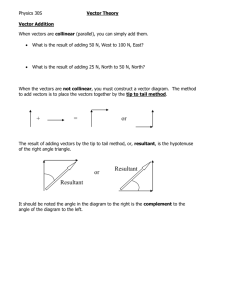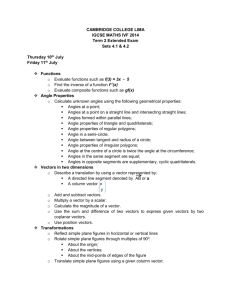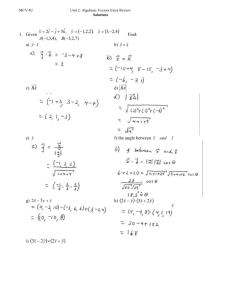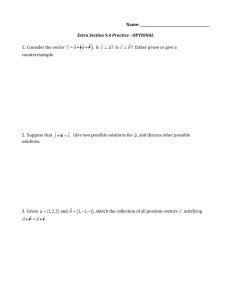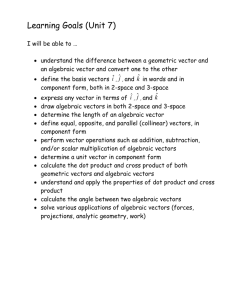VECTOR ADDITION LAB
advertisement
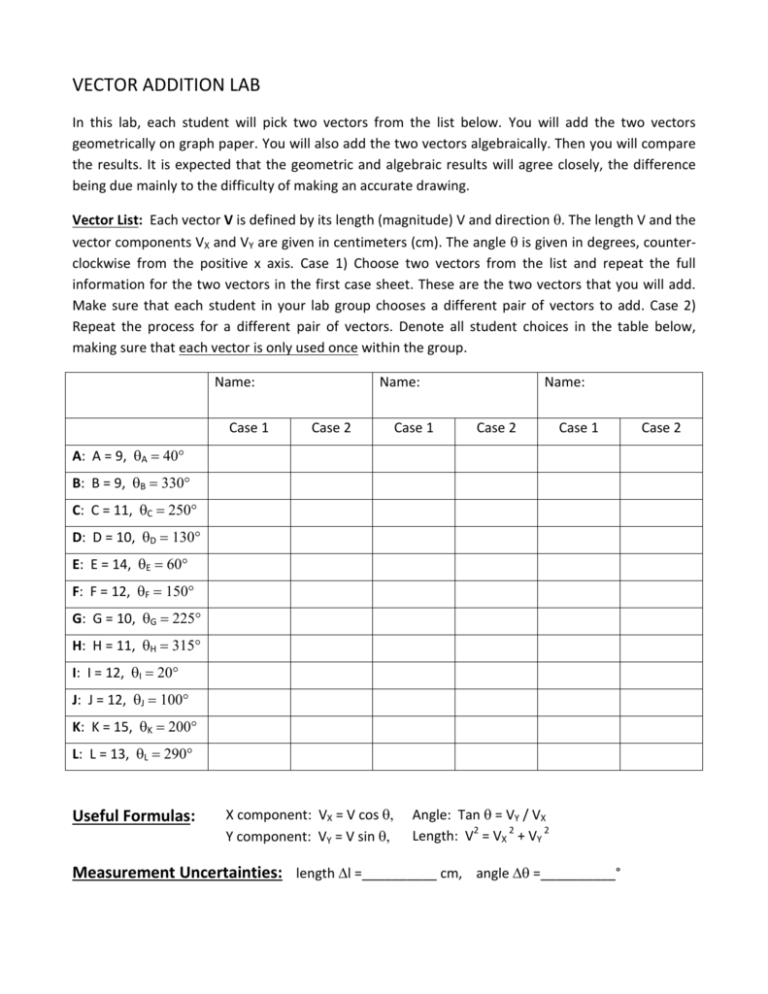
VECTOR ADDITION LAB In this lab, each student will pick two vectors from the list below. You will add the two vectors geometrically on graph paper. You will also add the two vectors algebraically. Then you will compare the results. It is expected that the geometric and algebraic results will agree closely, the difference being due mainly to the difficulty of making an accurate drawing. Vector List: Each vector V is defined by its length (magnitude) V and direction . The length V and the vector components VX and VY are given in centimeters (cm). The angle is given in degrees, counterclockwise from the positive x axis. Case 1) Choose two vectors from the list and repeat the full information for the two vectors in the first case sheet. These are the two vectors that you will add. Make sure that each student in your lab group chooses a different pair of vectors to add. Case 2) Repeat the process for a different pair of vectors. Denote all student choices in the table below, making sure that each vector is only used once within the group. Name: Case 1 Name: Case 2 Case 1 Name: Case 2 Case 1 A: A = 9, A B: B = 9, B C: C = 11, C D: D = 10, D E: E = 14, E F: F = 12, F G: G = 10, G H: H = 11, H I: I = 12, I J: J = 12, J K: K = 15, K L: L = 13, L Useful Formulas: X component: VX = V cos Angle: Tan = VY / VX 2 2 2 Y component: VY = V sin Length: V = VX + VY Measurement Uncertainties: length l =__________ cm, angle =__________° Case 2 CASE 1 Name: _________________ First vector: Length = ______ Angle = _____ Second vector: Length = ______ Angle = _____ Geometric Sum Use the tail-to-tip method to construct the sum of your two vectors. First sketch the sum on plain white paper; then add them carefully on graph paper, placing the origin of the coordinates so that the vectors and their sum will fit on the sheet. From the graph paper, measure the length and angle of the sum. Sum length: S = __________ cm , Sum angle: S Algebraic Sum Calculate the x and y components of your two vectors. Use the algebraic method to calculate the components of the sum. Finally calculate the length and angle of the sum. First vector components: X = __________ cm, Y = __________ cm Second vector components: X = __________ cm, Y = __________ cm Sum components: SX = ___________ cm, SY = __________ cm Sum length: S = __________ cm , Sum angle: S Comparison Now find out how accurate was your drawing. Consider the absolute difference between the results of the geometric sum and the algebraic sum. Length: What is the absolute difference, for the length of the sum? Difference = ________ cm Angle: What is the absolute difference, for the angle of the sum? Difference = ________ If your answers agree to within the measurement uncertainties, you did a good job. But if they differ by a much larger amount, there may be a problem with either your geometry or your algebra: Find the error! CASE 2 Name: _________________ First vector: Length = ______ Angle = _____ Second vector: Length = ______ Angle = _____ Geometric Sum Use the tail-to-tip method to construct the sum of your two vectors. First sketch the sum on plain white paper; then add them carefully on graph paper, placing the origin of the coordinates so that the vectors and their sum will fit on the sheet. From the graph paper, measure the length and angle of the sum. Sum length: S = __________ cm , Sum angle: S Algebraic Sum Calculate the x and y components of your two vectors. Use the algebraic method to calculate the components of the sum. Finally calculate the length and angle of the sum. First vector components: X = __________ cm, Y = __________ cm Second vector components: X = __________ cm, Y = __________ cm Sum components: SX = ___________ cm, SY = __________ cm Sum length: S = __________ cm , Sum angle: S Comparison Now find out how accurate was your drawing. Consider the absolute difference between the results of the geometric sum and the algebraic sum. Length: What is the absolute difference, for the length of the sum? Difference = ________ cm Angle: What is the absolute difference, for the angle of the sum? Difference = ________ If your answers agree to within the measurement uncertainties, you did a good job. But if they differ by a much larger amount, there may be a problem with either your geometry or your algebra: Find the error!


